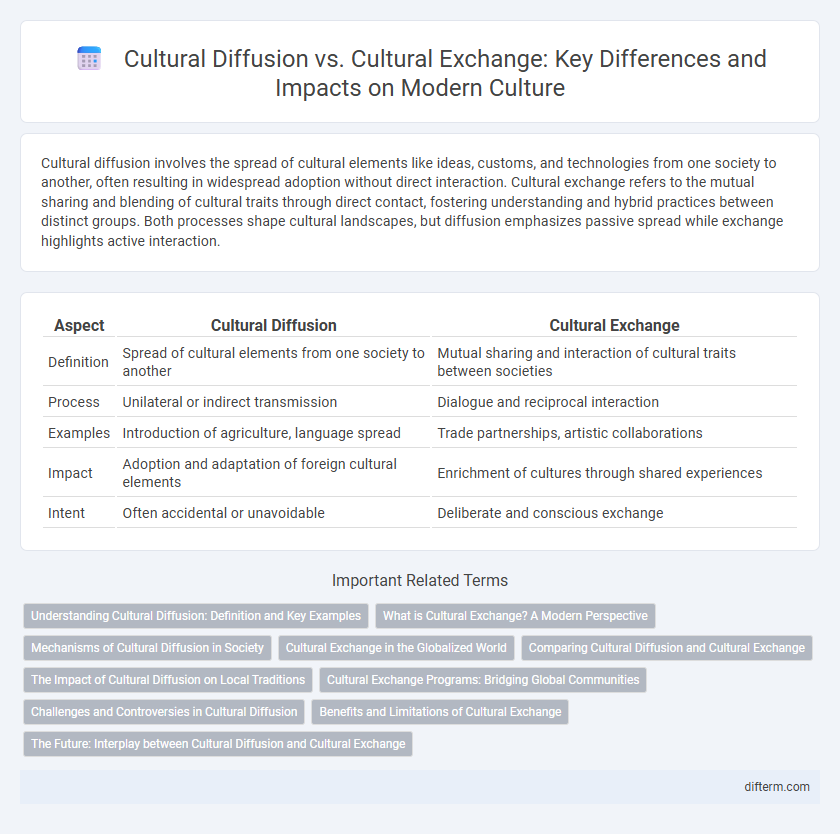Cultural diffusion involves the spread of cultural elements like ideas, customs, and technologies from one society to another, often resulting in widespread adoption without direct interaction. Cultural exchange refers to the mutual sharing and blending of cultural traits through direct contact, fostering understanding and hybrid practices between distinct groups. Both processes shape cultural landscapes, but diffusion emphasizes passive spread while exchange highlights active interaction.
Table of Comparison
| Aspect | Cultural Diffusion | Cultural Exchange |
|---|---|---|
| Definition | Spread of cultural elements from one society to another | Mutual sharing and interaction of cultural traits between societies |
| Process | Unilateral or indirect transmission | Dialogue and reciprocal interaction |
| Examples | Introduction of agriculture, language spread | Trade partnerships, artistic collaborations |
| Impact | Adoption and adaptation of foreign cultural elements | Enrichment of cultures through shared experiences |
| Intent | Often accidental or unavoidable | Deliberate and conscious exchange |
Understanding Cultural Diffusion: Definition and Key Examples
Cultural diffusion refers to the spread of cultural elements such as ideas, styles, religions, technologies, and languages from one society to another, often occurring through migration, trade, or conquest. Key examples include the Silk Road facilitating the exchange of goods and beliefs between Asia and Europe, and the spread of Buddhism from India to East Asia. Understanding cultural diffusion highlights how civilizations evolve by integrating external influences while retaining unique cultural identities.
What is Cultural Exchange? A Modern Perspective
Cultural exchange involves the reciprocal sharing of ideas, traditions, and values between different societies, fostering mutual understanding and respect. This dynamic process enriches communities by blending diverse artistic expressions, languages, and customs, contributing to global interconnectedness. In a modern perspective, cultural exchange emphasizes collaboration and dialogue, promoting inclusivity and combating cultural homogenization in an increasingly digital world.
Mechanisms of Cultural Diffusion in Society
Mechanisms of cultural diffusion in society include migration, trade, and communication, facilitating the spread of ideas, customs, and technologies across different groups. Cultural diffusion often occurs through direct contact or indirect influence, such as media and digital platforms, enabling societies to adopt and adapt cultural elements. These processes contribute to cultural diversity and interconnectedness while shaping social identities and collective behaviors.
Cultural Exchange in the Globalized World
Cultural exchange in the globalized world fosters mutual understanding by sharing art, traditions, and values across diverse societies, leading to enriched cultural identities. Unlike cultural diffusion, which often involves the unidirectional spread of cultural elements, cultural exchange emphasizes reciprocal interactions and collaboration among cultures. Global platforms, technological advancements, and international travel accelerate these exchanges, creating dynamic, interconnected cultural landscapes.
Comparing Cultural Diffusion and Cultural Exchange
Cultural diffusion involves the widespread transmission of cultural elements from one society to another, often occurring over extended periods through migration, trade, or conquest. Cultural exchange, by contrast, encompasses a more reciprocal and interactive sharing of cultural practices, ideas, and artifacts between groups within a specific timeframe. The key difference lies in diffusion's unidirectional spread versus the mutual, dynamic interaction characteristic of cultural exchange.
The Impact of Cultural Diffusion on Local Traditions
Cultural diffusion significantly reshapes local traditions by introducing new customs, technologies, and ideologies that blend with indigenous practices, creating hybrid cultural forms. This process often accelerates through globalization, migration, and digital communication, which expand cultural interactions beyond geographical boundaries. While cultural diffusion can enrich local heritage, it also poses challenges to preserving distinctive cultural identities against homogenizing influences.
Cultural Exchange Programs: Bridging Global Communities
Cultural exchange programs foster mutual understanding by enabling individuals from different backgrounds to share traditions, languages, and values firsthand, promoting global unity. These programs differ from cultural diffusion, which involves the passive spread of cultural elements over time, as exchange programs encourage active, intentional interaction and collaboration. By creating immersive experiences, cultural exchange initiatives bridge global communities, enhancing cross-cultural communication and respect.
Challenges and Controversies in Cultural Diffusion
Cultural diffusion often faces challenges such as misinterpretation, loss of cultural identity, and unequal power dynamics leading to cultural appropriation. Controversies emerge when dominant cultures impose their practices on marginalized groups, creating tensions and resistance. These issues highlight the complexities in balancing cultural sharing while respecting authenticity and diversity.
Benefits and Limitations of Cultural Exchange
Cultural exchange fosters mutual understanding and innovation by enabling diverse groups to share traditions, art, and knowledge, enriching societies worldwide. It promotes tolerance and global cooperation but may also risk cultural homogenization and the erosion of indigenous identities. Balancing the preservation of unique cultural heritages with the benefits of shared experiences remains a complex challenge in cultural interactions.
The Future: Interplay between Cultural Diffusion and Cultural Exchange
The future of cultural dynamics hinges on the interplay between cultural diffusion and cultural exchange, where diffusion spreads innovations globally while exchange fosters mutual understanding through direct interaction. Digital technologies accelerate cultural diffusion by enabling rapid dissemination of ideas across borders, yet authentic cultural exchange preserves the depth of traditional practices and local identities. Balancing these processes will shape a more interconnected yet culturally diverse world, emphasizing both global integration and cultural preservation.
cultural diffusion vs cultural exchange Infographic

 difterm.com
difterm.com